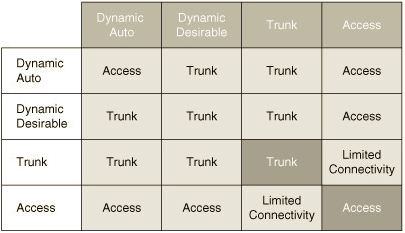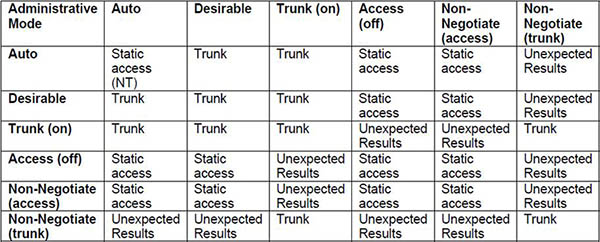VLAN Trunking 3
Question 1
Explanation
The “vlan dot1q tag native” command maintains the tagging on the native VLAN and drop untagged traffic -> B is correct.
Reference: http://www.cisco.com/web/techdoc/dc/reference/cli/nxos/commands/l2/vlan_dot1Q_tag_native.html
Question 2
Explanation
Interface Gi5/1 is using 802.1q trunking which is an open standard protocol -> A is not correct while D is correct.
From the output we see the native VLAN of Gi5/1 interface is VLAN 1 so all untagged traffic should belong to VLAN 1 (using the default setting) -> B is not correct.
In this question we can only guess that “The device is configured with the default MST region” (also referred to as IST or Internal Spanning Tree). The “show interface trunk” command does not display any information about MST.
Answer E may be correct as interface Gi6/2 is in forwarding state for VLAN 36 so it may be the root port for VLAN 36.
So in conclusion there are two possibly correct answers but we have to choose one. We believe answer C is better than E so we choose it the best answer left.
Note: Answer F is not correct because VLAN 600 is the native VLAN on Gi6/2 does not mean untagged traffic is tagged with this VLAN. It only means “all untagged traffic belongs to VLAN 600”.
Question 3
Question 4
Explanation
From the summary in the book of “Cisco Press’ SWITCH Foundation Learning Guide”:

We see an access port is formed when:
+ Both ports are in “Dynamic Auto”
+ One port in “Dynamic Auto” and the other port in “Access”
+ One port in “Dynamic Desirable” and the other port in “Access”
+ Both ports are in “Access”
Note: If you want to know what the result if one of the port is in “Nonegotiate” mode then this is the table you want:

Question 5
Question 6
Explanation
Although Gi0/10 has been configured as trunk it it did not appear in the “show interfaces trunk” command so the most suitable reason is it is down (not administratively down but down for another reason).
Question 7
Explanation
By entering the command “switch port trunk allowed vlan 2,3,4”, vlan 5 would be removed from allowed VLAN list. Both Workstations A & B are on VLAN 5 so they cannot communicate any more.
Note: If we want to add vlan 2 to 4 to the allowed VLAN list then we should use the “switchport trunk allowed vlan add 2,3,4”.
Question 8
Question 9
Question 10



Question 2
Correct answers are
D. Interface Gi5/1 is using an industry standard trunking protocol
F. On interface Gi6/2, all untagged traffic is tagged with VLAN 600
Here is why F is not a valid answer to Q2.
Native VLANs:
In some cases, an untagged frame will arrive on a tagged port. To handle this, tagged ports have a special VLAN configured on them called the untagged VLAN. This is also known as the ‘native VLAN’. The switch assigns any untagged frame that arrives on a tagged port to the native VLAN. If a frame on the native VLAN leaves a trunk (tagged) port, the switch strips the VLAN tag out. In short, the native VLAN is a way of carrying untagged traffic across one or more switches.
I believe Q3 and Q6 are different because Q3 shows config being input into the Switch, whereas Q6 looks like it’s showing the output of a “sho run int gig 0/10” command. If Q6 is the output of show run we would expect to see the “shutdown” command, and since this isn’t there it must just be because the link is down.
I’m not entirely sure why 3 is A and not B, they both seem to be saying the same thing to me. But it isn’t exactly a completed question anyway.
Just to clarify, I have done this in a quick lab and ports will only show in the output of “show int trunk” if they are both trunk ports (obviously) and up/up, so if a port is shutdown, or down it will not be displayed in the output.
Q5
I suppose C is correct. Question asks about tagging. Traffic from Voice VLAN will add 802.1p for passing CoS values. The set of commands in option C looks correct. Others sets are weird.
Q2 correct answers are D & F
Which two commands about SW1 are true? (Choose two)
A . Interface Gi5/1 is using a Cisco proprietary trunking protocol
B . On interface Gi5/1, all untagged traffic is tagged with VLAN 113
C . The device is configured with the default MST region.
D . Interface Gi5/1 is using an industry standard trunking protocol
E . Interface Gi6/2 is the root port for VLAN 36
F . On interface Gi6/2, all untagged traffic is tagged with VLAN 600